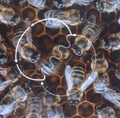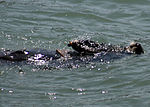 | Primate (redirect from Tool use by primates) with humans (genus Homo) capable of creating complex languages and sophisticated civilizations, and non-human primates are recorded to use tools. They... 158 KB (16,280 words) - 12:02, 2 May 2024 |
criticism. Hominini List of human evolution fossils Stone Age Stone tool Timeline of historic inventions Tool use by non-humans Dilley, James (2020-07-01)... 56 KB (4,986 words) - 16:47, 23 March 2024 |
Primate archaeology (category Tool-using mammals) non-human primate tools and their behaviour in tandem. Primate archaeology has the unique opportunity to observe the tool-use behaviors of extant non-human... 99 KB (11,124 words) - 04:29, 22 April 2024 |
 | Animal cognition (redirect from Non-human animal intelligence) encompasses the mental capacities of non-human animals including insect cognition. The study of animal conditioning and learning used in this field was developed... 121 KB (14,920 words) - 23:23, 25 April 2024 |
Twig (category Use dmy dates from April 2020) carbon dioxide used in photosynthesis. Twigs are a feature of tool use by non-humans. For example, chimpanzees have been observed using twigs to go "fishing"... 3 KB (316 words) - 20:57, 4 April 2024 |
inspired by the idea that tool use was the characteristic that separated mankind from the rest of the animal kingdom. Tool use by non-human animals "'Far... 6 KB (629 words) - 20:04, 18 April 2024 |
 | Bird intelligence (category Use dmy dates from September 2020) hooked tool from a wire with no prior experience, the only known species other than humans to do so. In 2014, a New Caledonian crow named "007" by researchers... 54 KB (6,669 words) - 02:37, 18 April 2024 |
 | Chimpanzee (redirect from Tool use by chimpanzees) "Diversity of tool use and tool-making in wild chimpanzees". In Berthelet, A.; Chavaillon, J. (eds.). The Use of Tools by Human and Non-human Primates. Oxford... 118 KB (12,797 words) - 13:53, 11 April 2024 |
 | Orangutan (redirect from Tool use by orangutans) from) but to humans suffering some serious medical condition (most likely cretinism) and that his use of the word was misunderstood by Nicolaes Tulp... 105 KB (10,975 words) - 21:31, 2 May 2024 |
 | Archaic humans is a broad category denoting all species of the genus Homo that are not Homo sapiens (which are known as modern humans). Among the earliest... 15 KB (1,420 words) - 05:32, 7 April 2024 |
 | Primate cognition (section Tool use) anthropology. Primates are capable of high levels of cognition; some make tools and use them to acquire foods and for social displays; some have sophisticated... 38 KB (4,656 words) - 20:40, 1 May 2024 |
First described in humans, a g factor has since been identified in a number of non-human species. Non-human models of g have been used in genetic and neurological... 11 KB (1,514 words) - 08:02, 2 May 2024 |
 | develop highly complex tools, and form complex social structures and civilizations. Humans are highly social, with individual humans tending to belong to... 262 KB (24,865 words) - 18:45, 1 May 2024 |
 | Instructional materials (category Articles using small message boxes) materials including animate and inanimate objects and human and non-human resources that a teacher may use in teaching and learning situations to help achieve... 5 KB (483 words) - 13:33, 22 March 2024 |
Artificial intelligence content detection (redirect from AI detection tool) slightly rearranged by humans and obfuscated by a paraphrasing tool". AI text detection software has also been shown to discriminate against non-native speakers... 14 KB (1,368 words) - 18:00, 24 April 2024 |
 | Animal sexual behaviour (redirect from Non-human animal sexuality) chromosomes of humans and chimps may have diverged around 1.2 million years after the other chromosomes. One possible explanation is that modern humans emerged... 128 KB (13,898 words) - 03:23, 17 March 2024 |
Origin of language (redirect from Evolution of language in humans) revealed to humans a core base of language—enabling humans to communicate with each other—and then humans invented the rest of language. Non-Committal:... 175 KB (21,463 words) - 20:05, 17 April 2024 |
Paleolithic era. Many traits of human intelligence, such as empathy, theory of mind, mourning, ritual, and the use of symbols and tools, are somewhat apparent... 107 KB (12,467 words) - 22:00, 28 April 2024 |
 | Oldowan (redirect from Pebble tool) stone. Oldowan tools were used during the Lower Paleolithic period, 2.9 million years ago up until at least 1.7 million years ago (Ma), by ancient Hominins... 66 KB (7,773 words) - 02:07, 16 April 2024 |
Human communication, or anthroposemiotics, is a field of study dedicated to understanding how humans communicate. Humans' ability to communicate with one... 33 KB (4,221 words) - 01:47, 10 February 2024 |
 | Homo (redirect from Early humans) species (collectively called archaic humans) classified as either ancestral or closely related to modern humans, including Homo erectus and Homo neanderthalensis... 91 KB (7,877 words) - 06:08, 2 May 2024 |
involves human beings as research subjects, commonly known as test subjects. Human subject research can be either medical (clinical) research or non-medical... 56 KB (6,693 words) - 20:30, 22 April 2024 |
 | Ethology (category Use dmy dates from July 2020) Cognitive ethology Deception in animals Human ethology List of abnormal behaviours in animals Tool use by non-human animals Matthews, Janice R.; Matthews... 35 KB (3,923 words) - 13:03, 1 May 2024 |






